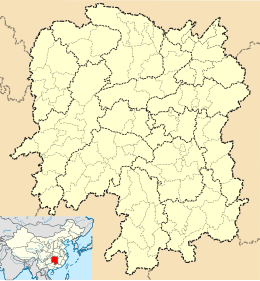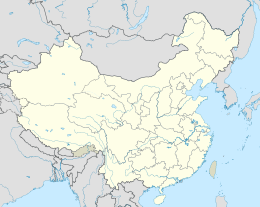-
A pavilion
-
Statues of notable Hunan people
-
-
-
Wangjiang Pavilion
-
-
-
-

Summary
Orange Isle (Chinese: 橘子洲; pinyin: Júzi Zhōu) is an isle in Xiang River, Changsha, Hunan, China.[1][2] It also known by other names, such as Ju Isle (橘洲; Jú Zhōu) and Shuilu Isle (水陆洲; 水陸洲; Shuǐlù Zhōu; 'Water-and-land Isle'). It has a length of 5 kilometres (3.1 mi), a width of 40 to 140 metres (130 to 460 ft) and a total area of 370,900 square metres (91.64 acres).[3][4] It was also a national AAAAA (5A) level tourist attraction and a national key scenic spot.[5]
 Orange Isle in 2006 | |||||||
 Orange Isle  Orange Isle | |||||||
| Geography | |||||||
|---|---|---|---|---|---|---|---|
| Location | Xiang River, Changsha, Hunan | ||||||
| Coordinates | 28°11′03″N 112°57′41″E / 28.184121°N 112.96129°E | ||||||
| Area | 91.64 acres (37.09 ha) | ||||||
| Length | 5 km (3.1 mi) | ||||||
| Width | 40–140 m (130–460 ft) | ||||||
| Administration | |||||||
China | |||||||
| Demographics | |||||||
| Population | 100 (administrators) | ||||||
| Languages | Mandarin, Xiang | ||||||
| Ethnic groups | Han Chinese | ||||||
| Additional information | |||||||
| Chinese name | |||||||
| Simplified Chinese | 橘子洲 | ||||||
| Traditional Chinese | 橘子洲 | ||||||
| |||||||
History edit
The first known instance of Orange Isle being documented appeared in 305 B.C., during the Yongxing era of the reign of Emperor Hui of Jin during the Jin Dynasty (266–420).[6]
During the Tang dynasty (618–907), poet Du Fu wrote a poem Visiting Daolin Temple and Yuelushan Temple (岳麓山道林二寺行; 嶽麓山道林二寺行; yuè lù shān dào lín èr sì xíng), which mentioned Orange Isle. It had been on the list of The Eight Views of Xiaoxiang - River and Sky: Sunset Snow.
Orange Isle was opened in 1904, during the late Qing dynasty (1644–1911).[6]
From 1911 to 1949, many foreign embassies and consulates were built on the isle.[1][6]
During Mao Zedong's early years, he lived in Changsha. He and his friends He Shuheng, Xiao Zisheng, Cai Hesen, Xiao San and Xiang Jingyu would swim in the Xiang River.[7]
Since the 2010s, the Orange Isle Music Festival has been hosted on the isle.[8][9][10][11]
On 20 December 2009, the Youth Mao Zedong Statue was built on the isle.[12][13]
Attractions edit
- Hunan Culture Corridor
- On-water Amusement Corridor
- Orange Garden
- Garden of the Nature
- Park of Harmonious Guests
- Plaza of Shopping and Foods
- GYM Center
- Relaxation Resort
- Wildlife Park
Gallery edit
Transportation edit
- Orange Isle Bridge, opened in 1972 as the first bridge crossing the Xiang River north of Hengyang, connects directly to the island's road network via two ramps, serving both eastbound and westbound traffic. Public access is restricted from 7:00 AM to 10:00 PM on weekends and national holidays.
- Juzizhou station on Changsha Metro's Line 2, opened in 2014, provides direct access to the park for pedestrians.
References edit
- ^ a b Wang Xijia (2014), p. 25.
- ^ "Orange Isle to Hold the Opening Ceremony of Hunan International Tourism Festival". enghunan.gov.cn. 2009. Archived from the original on 12 March 2014.
- ^ 长沙橘子洲风景区. Tencent (in Chinese). 1 June 2016.
- ^ "Brief Introduction to Orange Isle Scenic Spot". 2011. Retrieved 3 May 2018.
- ^ "橘子洲风景区". 腾讯大湘网. Retrieved 3 May 2019.
- ^ a b c 140年前的水陆洲,江神庙、拱极楼曾热闹非凡续. Xinhua (in Chinese). 2013. Archived from the original on 4 March 2016.
- ^ 伟人伫立橘洲头 毛泽东雕像背后的故事. Ifeng (in Chinese). 2009.
- ^ "Orange Isle Music Festival kick off in C China". Xinhua. 2010. Archived from the original on 31 March 2014.
- ^ "2013 Orange Isle Music Festival to Rock Changsha Sept 8-9". echinacities.com. 2013.
- ^ "the 2012 Orange Isle Music Festival". enghunan.gov.cn. 2012. Archived from the original on 20 May 2019. Retrieved 12 March 2014.
- ^ "3rd Orange Isle Music Festival". enghunan.gov.cn. 2013. Archived from the original on 19 May 2019. Retrieved 12 March 2014.
- ^ 32米高青年毛泽东像矗立橘子洲头. Ifeng (in Chinese). 2009.
- ^ 毛泽东诞辰116周年:橘子洲毛泽东雕塑揭幕. Red.net (in Chinese). 2009. Archived from the original on 12 March 2014. Retrieved 12 March 2014.
Bibliography edit
- Wang Xijia (2014). "Scenic Spots" 山水名胜. 长沙史话 [A Brief History of Changsha] (in Chinese). Beijing: Social Sciences Academic Press. ISBN 978-7-5097-6662-0.


